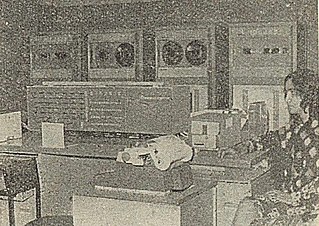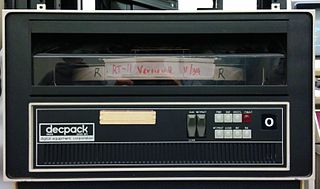Related Research Articles

In computing, BIOS is firmware used to provide runtime services for operating systems and programs and to perform hardware initialization during the booting process. The BIOS firmware comes pre-installed on an IBM PC or IBM PC compatible's system board and exists in some UEFI-based systems to maintain compatibility with operating systems that do not support UEFI native operation. The name originates from the Basic Input/Output System used in the CP/M operating system in 1975. The BIOS originally proprietary to the IBM PC has been reverse engineered by some companies looking to create compatible systems. The interface of that original system serves as a de facto standard.

Digital Equipment Corporation, using the trademark Digital, was a major American company in the computer industry from the 1960s to the 1990s. The company was co-founded by Ken Olsen and Harlan Anderson in 1957. Olsen was president until forced to resign in 1992, after the company had gone into precipitous decline.

Digital Equipment Corporation (DEC)'s PDP-10, later marketed as the DECsystem-10, is a mainframe computer family manufactured beginning in 1966 and discontinued in 1983. 1970s models and beyond were marketed under the DECsystem-10 name, especially as the TOPS-10 operating system became widely used.

The PDP–11 is a series of 16-bit minicomputers sold by Digital Equipment Corporation (DEC) from 1970 into the late 1990s, one of a set of products in the Programmed Data Processor (PDP) series. In total, around 600,000 PDP-11s of all models were sold, making it one of DEC's most successful product lines. The PDP-11 is considered by some experts to be the most popular minicomputer.

VAX is a series of computers featuring a 32-bit instruction set architecture (ISA) and virtual memory that was developed and sold by Digital Equipment Corporation (DEC) in the late 20th century. The VAX-11/780, introduced October 25, 1977, was the first of a range of popular and influential computers implementing the VAX ISA. The VAX family was a huge success for DEC – over 100 models were introduced over the lifetime of the design, with the last members arriving in the early 1990s. The VAX was succeeded by the DEC Alpha, which included several features from VAX machines to make porting from the VAX easier.

In computing, booting is the process of starting a computer as initiated via hardware such as a button or by a software command. After it is switched on, a computer's central processing unit (CPU) has no software in its main memory, so some process must load software into memory before it can be executed. This may be done by hardware or firmware in the CPU, or by a separate processor in the computer system.

RSX-11 is a discontinued family of multi-user real-time operating systems for PDP-11 computers created by Digital Equipment Corporation. In widespread use through the late 1970s and early 1980s, RSX-11 was influential in the development of later operating systems such as VMS and Windows NT.
RT-11 is a discontinued small, low-end, single-user real-time operating system for the full line of Digital Equipment Corporation PDP-11 16-bit computers. RT-11 was first implemented in 1970. It was widely used for real-time computing systems, process control, and data acquisition across all PDP-11s. It was also used for low-cost general-use computing.
ANDOS is a Russian operating system for Electronika BK series computers: BK-0010, BK-0011, and BK-0011M. They were based on the PDP-11 architecture by Digital Equipment Corporation. ANDOS was created in 1990 and released first in 1992. Initially it was developed by Alexey Nadezhin and later also by Sergey Kamnev, who joined the project. It was the only widespread system on BK series computers that used MS-DOS-compatible file system format. ANDOS used the FAT12 file system on 800 Kb floppy disks. For Electronika BK-0011M and BK-0011, ANDOS could emulate a BK-0010 by loading a BK-0010 read-only memory (ROM) image into BK-0011(M) random-access memory (RAM). In minimal configuration, the system could occupy less than 4 Kb of RAM.

The Electronika BK is a series of 16-bit PDP-11-compatible home computers developed under the Electronika brand by NPO Scientific Center, then the leading microcomputer design team in the Soviet Union. It is also the predecessor of the more powerful UKNC and DVK micros.
OS/8 is the primary operating system used on the Digital Equipment Corporation's PDP-8 minicomputer.

The history of computing hardware in the Eastern Bloc is somewhat different from that of the Western world. As a result of the CoCom embargo, computers could not be imported on a large scale from Western Bloc.
The SM-1420 (CM-1420) is a 16 bit DEC PDP-11/45 minicomputer clone, and the successor to SM-4 in Soviet Bloc countries. Under the direction of Minpribor it was produced in the Soviet Union and Bulgaria from 1983 onwards, and is more than twice as fast as its predecessor. Its closest western counterpart is the DEC PDP-11/45, which means that the Soviet technology trailed 11 years behind compared to the Digital Equipment Corporation equivalent machine.
SM EVM are several types of Soviet and Comecon minicomputers produced from 1975 through the 1980s.
Mobile Operating System is an operating system, a Soviet clone of Unix from the 1980s.

The Professional 325 (PRO-325), Professional 350 (PRO-350), and Professional 380 (PRO-380) are PDP-11 compatible microcomputers introduced in 1982 by Digital Equipment Corporation (DEC) as high-end competitors to the IBM PC.

DECmate was the name of a series of PDP-8-compatible computers produced by the Digital Equipment Corporation in the late 1970s and early 1980s. All of the models used an Intersil 6100 or Harris 6120 microprocessor which emulated the 12-bit DEC PDP-8 CPU. They were text-only and used the OS/78 or OS/278 operating systems, which were extensions of OS/8 for the PDP-8. Aimed at the word processing market, they typically ran the WPS-8 word-processing program. Later models optionally had Intel 8080 or Z80 microprocessors which allowed them to run CP/M. The range was a development of the VT78 which was introduced in July 1977.

The first Nairi computer was developed and launched into production in 1964, at the Yerevan Research Institute of Mathematical Machines, and were chiefly designed by Hrachya Ye. Hovsepyan. In 1965, a modified version called Nairi-M, and in 1967 versions called Nairi-S and Nairi-2, were developed. Nairi-3 and Nairi-3-1, which used integrated hybrid chips, were developed in 1970. These computers were used for a wide class of tasks in a variety of areas, including Mechanical Engineering and the Economics.

Digital Equipment Corporation's RK05 is a disk drive whose removable disk pack can hold about 2.5 megabytes of data. Introduced 1972, it is similar to IBM's 1964-introduced 2310, and uses a disk pack similar to IBM's 2315 disk pack, although the latter only held 1 megabyte. An RK04 drive, which has half the capacity of an RK05, was also offered.
References
- 1 2 Janez Skrubej (2012). The Cold War for Information Technology: The Inside Story. ISBN 978-1618978356.
- ↑ Soviet Physics: Uspekhi - Volume 27, Issues 1-6. 1984. p. 454.
- 1 2 3 Richard W. Judy; Robert W. Clough (1989). "Soviet computers in the 1980s". Advances in Computers - Volume 29. p. 288. ISBN 0080566618.
- ↑ Advances in Computers - Volume 30. 1990. p. 230. ISBN 0080566626.